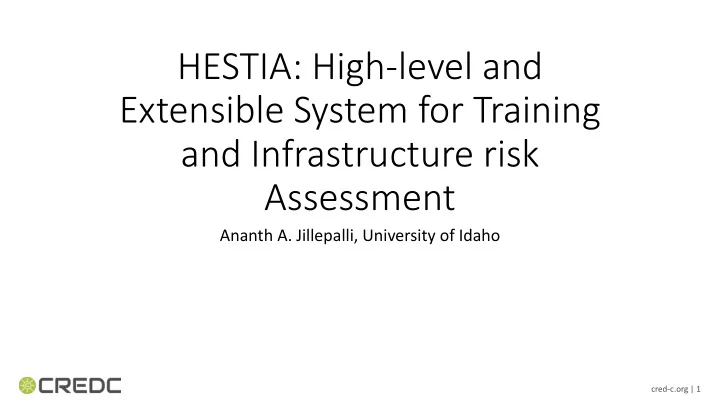

HESTIA: High-level and Extensible System for Training and Infrastructure risk Assessment Ananth A. Jillepalli, University of Idaho cred-c.org | 1
Introduction – Transition • Transition of Industrial Control Systems (ICS) into Cyber Physical Control Systems (CPCS). • Digital / analog equipment of ICS is being replaced by cyber-enabled equipment. cred-c.org | 2
Introduction – New Vector of Vulnerabilities • Increased connectivity of CPCS to the internet. • Open-source applications are purchased commercially off-the-shelf (COTS), without consideration of applying current standard patches. cred-c.org | 3
Introduction – Change in Attack Framework • Until recently, CPCS attacks originated from an insider threat. • In the recent years, attacks originating from outside are becoming frequent. cred-c.org | 4
Introduction – Financial Impact • Cyber-attacks on CPCS are occurring at an ever-increasing rate, incurring financial loss to both governments and industries. • Estimates project losses as high as $1.87 billion by 2018, due to cyber- attacks on CPCS infrastructure. cred-c.org | 5
Problem – Identifying Vulnerabilities • For a Chief Security Officer (CSO): • Identifying vulnerabilities specific to a particular CPCS infrastructure can be a challenge, if there is no high-level security policy specification. cred-c.org | 6
Problem – Designing best hardening strategy • Obtaining the high-level security policy specification of the existing CPCS state is not sufficient by itself. • A CSO should be able to design the best hardening strategy for their particular CPCS system. cred-c.org | 7
Problem – Designing best hardening strategy • Obtaining the high-level security policy specification of the existing CPCS state is not sufficient by itself. • A CSO should be able to design the best hardening strategy for their particular CPCS system. cred-c.org | 8
Problem – Required Investigation • Such a design process includes investigating: • “where to best use defense resources, which parts to harden, and in which particular order?” cred-c.org | 9
Problem – Investigation Factors • Several factors come into play: • Completeness and consistency of the CPCS infrastructure policies; • Likeliness of attacks and respective defenses against the particular system; • Overall cost of possible attacks versus overall cost of possible defenses. • Overall cost = Time and money. cred-c.org | 10
Problem – Investigation Factors • Several factors come into play: • Completeness and consistency of the CPCS infrastructure policies; • Likeliness of attacks and respective defenses against the particular system; • Overall cost of possible attacks versus overall cost of possible defenses. • Overall cost = Time and money. cred-c.org | 11
Proposed Solution – HESTIA • HESTIA: High-level and Extensible System for Training and Infrastructure risk Assessment. • Work in progress. cred-c.org | 12
Data Flow of HESTIA cred-c.org | 13
Data Flow of HESTIA cred-c.org | 14
Architecture of HESTIA cred-c.org | 15
Architecture of HESTIA cred-c.org | 16
Architecture of HESTIA cred-c.org | 17
Architecture of HESTIA cred-c.org | 18
Architecture of HESTIA cred-c.org | 19
Architecture of HESTIA cred-c.org | 20
Current Research Status and Conclusion • Developed a specification language called HERMES. • In process to develop the ‘Consistency check engine’. • We hope that this endeavor will contribute to solving the problem of enabling a CSO to design the best hardening strategy. cred-c.org | 21
http://cred-c.org @credcresearch facebook.com/credcresearch/ Funded by the U.S. Department of Energy and the U.S. Department of Homeland Security
Recommend
More recommend